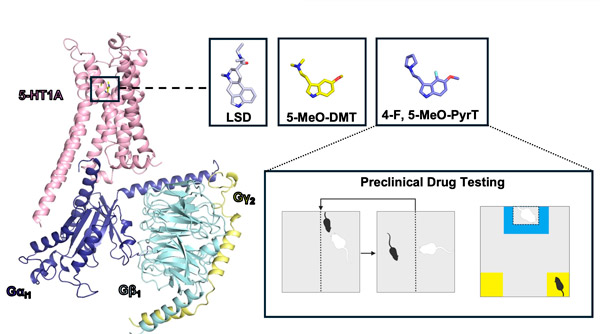
西奈山伊坎医学院的研究人员揭示了一类迷幻药物与血清素受体结合并激活的复杂机制,从而对抑郁症和焦虑症等神经精神疾病患者产生潜在的治疗效果。
在《自然》杂志上发表的一项研究中,研究小组报告称,某些迷幻药与大脑中血清素受体家族中一个不太了解的成员——5-HT1A——相互作用,在动物模型中产生治疗效果。
“LSD 和裸盖菇素等迷幻药正在进行临床试验,早期结果令人鼓舞,尽管我们仍然不了解它们如何与大脑中的各种分子靶点相互作用以产生治疗效果,”第一作者、西奈山伊坎生物医学科学研究生院博士生奥黛丽沃伦说。
“我们的研究首次强调了 5-HT1A 等血清素受体如何调节迷幻体验的主观影响,并在临床观察到的治疗结果中发挥潜在的关键作用。”
LSD 和 5-MeO-DMT(一种在科罗拉多河蟾蜍的分泌物中发现的迷幻药)因其通过 5-HT2A 血清素受体产生的致幻作用而闻名,尽管这些药物也能激活 5-HT1A,而 5-HT1A 是治疗抑郁症和焦虑症的经过验证的治疗靶点。
该团队与合著者、哥伦比亚大学化学系教授 Dalibor Sames 博士密切合作,合成了 5-MeO-DMT 衍生物,并在细胞信号传导分析和低温电子显微镜下进行了测试,以确定最有可能导致 5-HT1A 优先激活而不是 5-HT2A 的化学成分。
这种方法最终发现,一种名为 4-F,5-MeO-PyrT 的化合物对 5-HT1A 的选择性最高。西奈山伊坎脑与身体研究中心和情感神经科学中心主任 Scott Russo 博士实验室的讲师 Lyonna Parise 博士随后在抑郁症小鼠模型中测试了这种先导化合物,结果表明 4-F,5-MeO-PyrT 具有抗抑郁作用,且该作用可通过 5-HT1A 进行有效调节。
“我们能够微调 5-MeO-DMT/血清素平台,以在 5-HT1A 界面产生最大活性,并在 5-HT2A 产生最小活性,”资深作者、西奈山伊坎医学院药理学和神经科学副教授 Daniel Wacker 博士解释道。
我们的研究结果表明,除 5-HT2A 之外的其他受体不仅能调节迷幻药的行为效应,还可能对其治疗潜力产生重大贡献。事实上,我们对这种受体对 5-MeO-DMT 的强大贡献感到惊喜,目前 5-MeO-DMT 正在多项临床试验中接受抑郁症治疗的测试。我们相信,我们的研究将有助于更好地理解迷幻药复杂的药理学,因为它涉及多种受体类型。

西奈山的科学家们利用低温电子显微镜拍摄了血清素受体和经临床验证的药物靶点5-HT1A的详细照片,以展示迷幻药LSD和5-MeO-DMT,以及5-HT1A选择性衍生物5-MeO-DMT(4-F, 5-MeO-PyrT)如何与其结合。研究团队还发现,4-F, 5-MeO-DMT通过5-HT1A在小鼠模型中发挥抗抑郁作用,这可能与临床试验中观察到的迷幻药的治疗效果有关。作者:药理学博士Audre Warren和药学与神经科学副教授Daniel Wacker。
研究人员希望,他们的突破性发现能很快促成新型迷幻药物的研发,这些药物不具备现有药物的致幻特性。令人期待的是,他们发现,他们的先导化合物——最具选择性的5-HT1A类似物5-MeO-DMT——表现出抗抑郁作用,且不会产生与5-HT2A相关的幻觉。
科学家的另一个直接目标是研究 5-MeO-DMT 在抑郁症临床前模型中的影响(鉴于涉及迷幻药的研究的局限性,对 5-MeO-DMT 衍生物的研究仅限于动物模型)。
“我们已经证明迷幻药具有涉及多种不同受体类型的复杂生理效应,”第一作者沃伦强调说,“现在我们准备在此发现的基础上开发出针对多种精神疾病的改进治疗方法。”

